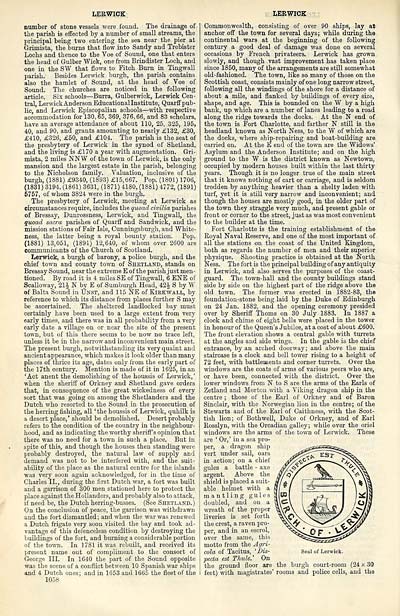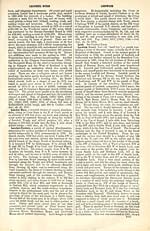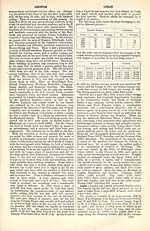Ordnance gazetteer of Scotland
(1066) Page 1058
Download files
Complete book:
Individual page:
Thumbnail gallery: Grid view | List view

LERWICK
number of stone vessels were found. The drainage of
the parish is effected by a number of small streams, the
principal being two entering the sea near the pier at
Grimista, the burns that flow into Sandy and Trebister
Lochs and thence to the Voe of Sound, one that enters
the head of Gulber Wick, one from Brindister Loch, and
one in the SW that flows to Fitch Burn in Tingwall
parish. Besides Lerwick burgh, the parish contains
also the hamlet of Sound, at the head of Voe of
Sound. The churches are noticed in the following
article. Sis schools — Burra, Gulberwick, Lerwick Cen-
tral, Lerwick Anderson Educational Institute, Quart! pub-
lic, and Lerwick Episcopalian schools — with respective
accommodation for 130,65, 369, 376,66, and 83 scholars,
have an average attendance of about 110, 25, 325, 195,
40, and 90, and grants amounting to nearly £132, £30,
£410, £326, £50, and £104. The parish is the seat of
the presbytery of Lerwick in the synod of Shetland,
and the living is £170 a year with augmentation. Gri-
mista, 2 miles NNW of the town of Lerwick, is the only
mansion and the largest estate in the parish, belonging
to the Nicholson family. Valuation, inclusive of the
burgh, (1881) £9340, (1893) £15,667. Pop. (1801) 1706,
(1831) 3194, (1861) 3631, (1871) 4180, (1881) 4772, (1891)
5757, of whom 3824 were in the burgh.
The presbytery of Lerwick, meeting at Lerwick as
circumstances require, includes the quoad civilia parishes
of Bressay, Dunrossness, Lerwick, and Tingwall, the
quoad sacra parishes of Quarff and Sandwick, and the
mission stations of Fair Isle, Cunningsburgh, and White-
ness, the latter being a royal bounty station. Pop.
(1881) 13,051, (1891) 12,640, of whom over 2600 are
communicants of the Church of Scotland.
Lerwick, a burgh of barony, a police burgh, and the
chief town and county town of Shetland, stands on
Bressay Sound, near the extreme E of the parish just men-
tioned. By road it is 4 miles SE of Tingwall, 6 ENE of
Scalloway, 21J N by E of Sumburgh Head, 42J S by W
of Balta Sound in Unst, and 115 NE of Kikkwall, by
reference to which its distance from places further S may
be ascertained. The sheltered landlocked bay must
certainly have been used to a large extent from very
early times, and there was in all probability from a very
early date a village on or near the site of the present
town, but of this there seems to be now no trace left,
unless it be in the narrow and inconvenient main street.
The present burgh, notwithstanding its very quaint and
ancient appearance, which makes it look older than many
places of thrice its age, dates only from the early part of
the 17th century. Mention is made of it in 1625, in an
'Act anent the demolishing of the houssis of Lerwick,'
when the sheriff of Orkney and Shetland gave orders
that, in consequence of the great wickedness of every
sort that was going on among the Shetlanders and the
Dutch who resorted to the Sound in the prosecution of
the herring fishing, all ' the houssis of Lerwick, quhilk is
a desert place, ' should be demolished. Desert probably
refers to the condition of the country in the neighbour-
hood, and as indicating the worthy sheriff's opinion that
there was no need for a town in such a place. But in
spite of this, and though the houses then standing were
probably destroyed, the natural law of supply and
demand was not to be interfered with, and the suit-
ability of the place as the natural centre for the islands
was very soon again acknowledged, for in the time of
Charles II., during the first Dutch war, a fort was built
and a garrison of 300 men stationed here to protect the
place against the Hollanders, and probably also to attack,
if need be, the Dutch herring- busses. (See Shetland. )
On the conclusion of peace, the garrison was withdrawn
and the fort dismantled ; and when the war was renewed
a Dutch frigate very soon visited the bay and took ad-
vantage of this defenceless condition by destroying the
buildings of the fort, and burning a considerable portion
of the town. In 1781 it was rebuilt, and received its
present name out of compliment to the consort of
George III. In 1640 the part of the Sound opposite
was the scene of a conflict between 10 Spanish war ships
and 4 Dutch ones; and in 1653 and 1665 the fleet of the
1058
LERWICK
Commonwealth, consisting of over 90 ships, lay at
anchor off the town for several days; while during the
continental wars at the beginning of the following
century a good deal of damage was done on several
occasions by French privateers. Lerwick has grown
slowly, and though vast improvement has taken place
since 1850, many of the arrangements are still somewhat
old-fashioned. The town, like so many of those on the
Scottish coast, consists mainly of one long narrow street,
following all the windings of the shore for a distance of
about a mile, and flanked by buildings of every size,
shape, and age. This is bounded on the W by a high
bank, up which are a number of lanes leading to a road
along the ridge towards the docks. At the N end of
the town is Fort Charlotte, and farther N still is the
headland known as North Ness, to the W of which are
the docks, where ship-repairing and boat-building are
carried on. At the E end of the town are the Widows'
Asylum and the Anderson Institute; and on the high
ground to the W is the district known as Newtown,
occupied by modern houses built within the last thirty
years. Though it is no longer true of the main street
that it knows nothing of cart or carriage, and is seldom
trodden by anything heavier than a shelty laden with
turf, yet it is still very narrow and inconvenient; and
though the houses are mostly good, in the older part of
the town they straggle very much, and present gable or
front or corner to the street, just as was most convenient
to the builder at the time.
Fort Charlotte is the training establishment of the
Royal Naval Reserve, and one of the most important of
all the stations on the coast of the United Kingdom,
both as regards the number of men and their superior
physique. Shooting practice is obtained at the North
Ness. The fort is the principal building of any antiquity
in Lerwick, and also serves the purposes of the coast-
guard. The town-hall and the county buildings stand
side by side on the highest part of the ridge above the
old town. The former was erected in 1882-83, the
foundation-stone being laid by the Duke of Edinburgh
on 24 Jan. 1882, and the opening ceremony presided
over by Sheriff Thorns on 30 July 1883. In 1887 a
clock and chime of eight bells were placed in the tower
in honour of the Queen's Jubilee, at a cost of about £600.
The front elevation shows a central gable with turrets
at the angles and side wings. In the gable is the chief
entrance, by an arched doorway; and above the main
staircase is a clock and bell tower rising to a height of
72 feet, with battlements and corner turrets. Over the
windows are the coats of arms of various peers who are,
or have been, connected with the district. Over the
lower windows from N to S are the arms of the Earls of
Zetland and Morton with a Viking dragon ship in the
centre ; those of the Earl of Orkney and of Baron
Sinclair, with the Norwegian lion in the centre; of the
Stewarts and of the Earl of Caithness, with the Scot-
tish lion; of Both well, Duke of Orkney, and of Earl
Rosslyn, with the Orcadian galley; while over the oriel
windows are the arms of the town of Lerwick. These
are ' Or, ' in a sea pro-
per, a dragon ship
vert under sail, oars
in action; on a chief
gules a battle - axe
argent. Above the
shield is placed a suit-
able helmet with a
mantling gules
doubled, and on a
wreath of the proper
liveries is set forth
the crest, a raven pro-
per, and in an escrol,
over the same, this
motto from the Agri-
cola of Tacitus, ' Dis- Seal of Lerwick.
pecta est Thule.' On
the ground floor are the burgh court-room (24 x 30
feet) with magistrates' rooms and police cells, and the
number of stone vessels were found. The drainage of
the parish is effected by a number of small streams, the
principal being two entering the sea near the pier at
Grimista, the burns that flow into Sandy and Trebister
Lochs and thence to the Voe of Sound, one that enters
the head of Gulber Wick, one from Brindister Loch, and
one in the SW that flows to Fitch Burn in Tingwall
parish. Besides Lerwick burgh, the parish contains
also the hamlet of Sound, at the head of Voe of
Sound. The churches are noticed in the following
article. Sis schools — Burra, Gulberwick, Lerwick Cen-
tral, Lerwick Anderson Educational Institute, Quart! pub-
lic, and Lerwick Episcopalian schools — with respective
accommodation for 130,65, 369, 376,66, and 83 scholars,
have an average attendance of about 110, 25, 325, 195,
40, and 90, and grants amounting to nearly £132, £30,
£410, £326, £50, and £104. The parish is the seat of
the presbytery of Lerwick in the synod of Shetland,
and the living is £170 a year with augmentation. Gri-
mista, 2 miles NNW of the town of Lerwick, is the only
mansion and the largest estate in the parish, belonging
to the Nicholson family. Valuation, inclusive of the
burgh, (1881) £9340, (1893) £15,667. Pop. (1801) 1706,
(1831) 3194, (1861) 3631, (1871) 4180, (1881) 4772, (1891)
5757, of whom 3824 were in the burgh.
The presbytery of Lerwick, meeting at Lerwick as
circumstances require, includes the quoad civilia parishes
of Bressay, Dunrossness, Lerwick, and Tingwall, the
quoad sacra parishes of Quarff and Sandwick, and the
mission stations of Fair Isle, Cunningsburgh, and White-
ness, the latter being a royal bounty station. Pop.
(1881) 13,051, (1891) 12,640, of whom over 2600 are
communicants of the Church of Scotland.
Lerwick, a burgh of barony, a police burgh, and the
chief town and county town of Shetland, stands on
Bressay Sound, near the extreme E of the parish just men-
tioned. By road it is 4 miles SE of Tingwall, 6 ENE of
Scalloway, 21J N by E of Sumburgh Head, 42J S by W
of Balta Sound in Unst, and 115 NE of Kikkwall, by
reference to which its distance from places further S may
be ascertained. The sheltered landlocked bay must
certainly have been used to a large extent from very
early times, and there was in all probability from a very
early date a village on or near the site of the present
town, but of this there seems to be now no trace left,
unless it be in the narrow and inconvenient main street.
The present burgh, notwithstanding its very quaint and
ancient appearance, which makes it look older than many
places of thrice its age, dates only from the early part of
the 17th century. Mention is made of it in 1625, in an
'Act anent the demolishing of the houssis of Lerwick,'
when the sheriff of Orkney and Shetland gave orders
that, in consequence of the great wickedness of every
sort that was going on among the Shetlanders and the
Dutch who resorted to the Sound in the prosecution of
the herring fishing, all ' the houssis of Lerwick, quhilk is
a desert place, ' should be demolished. Desert probably
refers to the condition of the country in the neighbour-
hood, and as indicating the worthy sheriff's opinion that
there was no need for a town in such a place. But in
spite of this, and though the houses then standing were
probably destroyed, the natural law of supply and
demand was not to be interfered with, and the suit-
ability of the place as the natural centre for the islands
was very soon again acknowledged, for in the time of
Charles II., during the first Dutch war, a fort was built
and a garrison of 300 men stationed here to protect the
place against the Hollanders, and probably also to attack,
if need be, the Dutch herring- busses. (See Shetland. )
On the conclusion of peace, the garrison was withdrawn
and the fort dismantled ; and when the war was renewed
a Dutch frigate very soon visited the bay and took ad-
vantage of this defenceless condition by destroying the
buildings of the fort, and burning a considerable portion
of the town. In 1781 it was rebuilt, and received its
present name out of compliment to the consort of
George III. In 1640 the part of the Sound opposite
was the scene of a conflict between 10 Spanish war ships
and 4 Dutch ones; and in 1653 and 1665 the fleet of the
1058
LERWICK
Commonwealth, consisting of over 90 ships, lay at
anchor off the town for several days; while during the
continental wars at the beginning of the following
century a good deal of damage was done on several
occasions by French privateers. Lerwick has grown
slowly, and though vast improvement has taken place
since 1850, many of the arrangements are still somewhat
old-fashioned. The town, like so many of those on the
Scottish coast, consists mainly of one long narrow street,
following all the windings of the shore for a distance of
about a mile, and flanked by buildings of every size,
shape, and age. This is bounded on the W by a high
bank, up which are a number of lanes leading to a road
along the ridge towards the docks. At the N end of
the town is Fort Charlotte, and farther N still is the
headland known as North Ness, to the W of which are
the docks, where ship-repairing and boat-building are
carried on. At the E end of the town are the Widows'
Asylum and the Anderson Institute; and on the high
ground to the W is the district known as Newtown,
occupied by modern houses built within the last thirty
years. Though it is no longer true of the main street
that it knows nothing of cart or carriage, and is seldom
trodden by anything heavier than a shelty laden with
turf, yet it is still very narrow and inconvenient; and
though the houses are mostly good, in the older part of
the town they straggle very much, and present gable or
front or corner to the street, just as was most convenient
to the builder at the time.
Fort Charlotte is the training establishment of the
Royal Naval Reserve, and one of the most important of
all the stations on the coast of the United Kingdom,
both as regards the number of men and their superior
physique. Shooting practice is obtained at the North
Ness. The fort is the principal building of any antiquity
in Lerwick, and also serves the purposes of the coast-
guard. The town-hall and the county buildings stand
side by side on the highest part of the ridge above the
old town. The former was erected in 1882-83, the
foundation-stone being laid by the Duke of Edinburgh
on 24 Jan. 1882, and the opening ceremony presided
over by Sheriff Thorns on 30 July 1883. In 1887 a
clock and chime of eight bells were placed in the tower
in honour of the Queen's Jubilee, at a cost of about £600.
The front elevation shows a central gable with turrets
at the angles and side wings. In the gable is the chief
entrance, by an arched doorway; and above the main
staircase is a clock and bell tower rising to a height of
72 feet, with battlements and corner turrets. Over the
windows are the coats of arms of various peers who are,
or have been, connected with the district. Over the
lower windows from N to S are the arms of the Earls of
Zetland and Morton with a Viking dragon ship in the
centre ; those of the Earl of Orkney and of Baron
Sinclair, with the Norwegian lion in the centre; of the
Stewarts and of the Earl of Caithness, with the Scot-
tish lion; of Both well, Duke of Orkney, and of Earl
Rosslyn, with the Orcadian galley; while over the oriel
windows are the arms of the town of Lerwick. These
are ' Or, ' in a sea pro-
per, a dragon ship
vert under sail, oars
in action; on a chief
gules a battle - axe
argent. Above the
shield is placed a suit-
able helmet with a
mantling gules
doubled, and on a
wreath of the proper
liveries is set forth
the crest, a raven pro-
per, and in an escrol,
over the same, this
motto from the Agri-
cola of Tacitus, ' Dis- Seal of Lerwick.
pecta est Thule.' On
the ground floor are the burgh court-room (24 x 30
feet) with magistrates' rooms and police cells, and the
Set display mode to: Large image | Transcription
Images and transcriptions on this page, including medium image downloads, may be used under the Creative Commons Attribution 4.0 International Licence unless otherwise stated. ![]()
| Gazetteers of Scotland, 1803-1901 > Ordnance gazetteer of Scotland > (1066) Page 1058 |
|---|
| Permanent URL | https://digital.nls.uk/97406038 |
|---|

